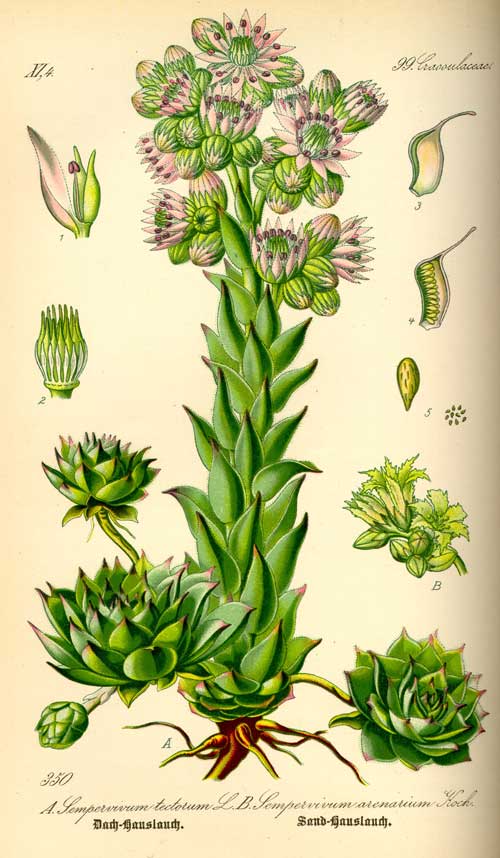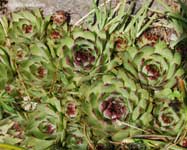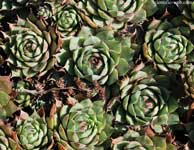
Sempervivum tectorum
Classification System: APG IV
Superregnum: Eukaryota
Regnum: Plantae
Cladus: Angiosperms
Cladus: Eudicots
Cladus: Core eudicots
Ordo: Saxifragales
Familia: Crassulaceae
Subfamilia: Sempervivoideae
Tribus: Semperviveae
Genus: Sempervivum
Species: Sempervivum tectorum
Subspecies: S. t. subsp. cebennense – S. t. subsp. tectorum
Name
Sempervivum tectorum L. (1753)
Hybrids
S. × calcaratum – S. × funckii – S. × hayekii – S. × piliferum – S. × stenopetalum – S. × widderi – S. × wolfianum
References
Linnaeus, C. 1753. Species Plantarum 1: 464.
USDA, ARS, Germplasm Resources Information Network. Sempervivum tectorum in the Germplasm Resources Information Network (GRIN), U.S. Department of Agriculture Agricultural Research Service. Accessed: 07-Oct-06.
Vernacular names
čeština: Netřesk střešní
dansk: Almindelig Husløg
Deutsch: Dach-Hauswurz
English: Common houseleek, Jove's beard, Jupiter's eye, Thor's beard, thunder plant, St. George's Beard
suomi: Kattomehitähti
français: Joubarbe des toits
hornjoserbsce: Třěšny rozkólnik
magyar: Fali kövirózsa
Nederlands: Gewone huislook, donderblad, donderbaard
norsk: Takløk
polski: Rojnik murowy
Scots: Fous
slovenčina: Skalnica strechová
српски / srpski: Чуваркућа
svenska: Taklök
vèneto: Articioco de muro
Sempervivum tectorum, the common houseleek,[1] is a species of flowering plant in the family Crassulaceae, native to the mountains of southern Europe, cultivated in the whole of Europe for its appearance and a Roman tradition claiming that it protects buildings against lightning strikes.
Description
Growing to 15 cm (6 in) tall by 50 cm (20 in) broad, it is a rosette-forming succulent evergreen perennial, spreading by offsets. It has grey-green, tufted, sessile leaves, 4–10 cm (2–4 in) in diameter, which are often suffused with rose-red. In summer it bears clusters of reddish-purple flowers, in multiples of 8-16, on hairy erect flat-topped stems.[2][3][4][5] The species is highly variable, in part because hundreds of cultivars have been propagated, sold, and traded for nearly 200 years.[5]
Sempervivum tectorum was described in 1753 by Linnaeus, who noted that its leaves are ciliate, that is, fringed with hairs.[3]
Names
This plant has been known to humans for thousands of years, and has attracted many common names and traditions. In addition to common houseleek, names include variations of the following:-
bullock's beard
devil's beard
earwort
fuet
healing blade
homewort
imbroke
Jove's beard
Jupiter's eye
poor Jan's leaf
red-leaved houseleek
roof foil
roof houseleek
St. George's Beard[6]
St. Patrick's cabbage
sengreen
Thor's beard
thunderplant
Welcome-home-husband-though-never-so-drunk[7]—a name it sometimes shares with Sedum acre.[8]
hen and chicks - a name shared with several other plants[9]
The specific epithet tectorum means "of house roofs", referring to a traditional location for these plants.[10]
Cultivation
Sempervivum tectorum is one of several houseleek species to be cultivated. It is valued as groundcover for hot, dry places. It has gained the Royal Horticultural Society's Award of Garden Merit.[11][12]
Folklore and herbalism
The plant has been traditionally thought to protect against thunderstorms, and grown on house roofs for that reason,[13] which is why it is called House Leek.[6] Many of its popular names in different languages reflect an association with the Roman thunder-god Jupiter, notably the Latin barba Jovis (Jupiter's beard), referred to in the Floridus traditionally attributed to Aemilius Macer,[14] and its French derivative joubarbe, which has in turn given rise to jubard and jo-barb in English; or with the Norse thunder-god Thor as in German Donnerbart.[15] It is also called simply thunder-plant.[16] Anglo-Saxon þunorwyrt[17][18] may have either meaning. However, the association with Jupiter has also been derived from a resemblance between the flowers and the god's beard; in modern times, it has also been called St. George's beard.[6]
The hairs that fringe the leaves can be seen on close inspection
Other common names, such as Anglo-Saxon singrēne, Modern English sigrim, sil-green, etc. and aye-green,[16][19][20] refer to its longevity. William Fernie tells a tale in support of this:
History relates that a botanist tried hard for eighteen months to dry a plant of the House Leek for his herbarium, but failed in this object. He afterwards restored it to its first site when it grew again as if nothing had interfered with its ordinary life.[6]
It has been believed to protect more generally against decay and against witchcraft.[6] Jacob Grimm quotes a Provençal troubadour: "e daquel erba tenon pro li vilan sobra lur maiso" — "and that plant they keep against evil atop their house."[21] In his Capitulare de villis vel curtis imperii, Charlemagne recommended it be grown on top of houses.[22] In some places, S. tectorum is still traditionally grown on the roofs of houses.[23][24]
The juice has been used in herbal medicine as an astringent and treatment for skin and eye diseases, including by Galen and Dioscorides, to ease inflammation and, mixed with honey, to treat thrush; however, large doses have an emetic effect.[25] Pliny also mentions it, and Marcellus Empiricus listed it as a component in external treatments for contusions, nervous disorders, intestinal problems and abdominal pain, and mixed with honey, as part of the antidotum Hadriani (Hadrian's antidote), a broad-spectrum palliative for internal complaints.[26]
Romans grew the plant in containers in front of windows and associated it with love medicine.[6]
References
"Sempervivum tectorum L. common houseleek". USDA. Retrieved 7 July 2011.
Brickell, Christopher, ed. (2008). The Royal Horticultural Society A-Z Encyclopedia of Garden Plants (3rd ed.). London: Dorling Kindersley. p. 1136. ISBN 978-1405332965.
Linnæus (1753), "Sempervivum", Species plantarum, vol. 1, Holmiae, p. 464, retrieved 6 July 2011
Linnaeus (1754), "Sempervivum", Gen. Pl. (5 ed.), p. 209, retrieved 6 July 2011
Linnaeus (1753), "Sempervivum tectorum", Species Plantarum, vol. 1, Flora of North America, p. 464, retrieved 6 July 2011
Fernie, William Thomas (2008) [Bristol: Wright, 1914]. Herbal Simples Approved for Modern Uses of Cure (3rd ed.). Teddington: Echo Library. p. 189. ISBN 978-1-4068-7552-2.
Watts, Donald (2007). Dictionary of Plant Lore. Elsevier. p. 202. ISBN 978-0-12-374086-1.
Fenton, James. "Clare Was Right". NY Review of Books. Retrieved 7 July 2011.
David Beaulieu. "Hens and Chicks".
Harrison, Lorraine (2012). RHS Latin for gardeners. United Kingdom: Mitchell Beazley. p. 224. ISBN 9781845337315.
"RHS Plant Selector - Sempervivum tectorum". Retrieved 5 March 2021.
"AGM Plants - Ornamental" (PDF). Royal Horticultural Society. July 2017. p. 96. Retrieved 9 November 2018.
Cockayne, Oswald (1866), "Hamƿyɼꞇ", Leechdoms, Wortcunning, and Starcraft of Early England: Being a Collection of Documents, for the most part never before printed, illustrating the History of Science in this Country Before the Norman Conquest, Rerum Britannicarum Medii Aevi Scriptores or Chronicles and Memorials of Great Britain and Ireland During the Middle Ages [The Rolls Series], vol. 3, London: Longman, p. 329
Fernie (2008), p. 189. "Quem sempervivam dicunt quoniam viret omni Tempore—'Barba Jovis' vulgari more vocatur" – "Which they call semperviva because it will live for all time—'beard of Jove' it is called by vulgar custom."
Grimm, Jacob (1882), Teutonic Mythology, vol. 1, translated by James Steven Stallybrass, London: Bell, p. 183; however, Grimm (1883), Teutonic Mythology, vol. 4, p. 1672 states that Donner-bart is sedum telephium.
Britten, James; Holland, Robert (1878), A Dictionary of English Plant-Names, English Dialect Society, London: Trübner, p. 610 and individual listings.
Grimm (1883), p. 1346.
Toller, T. Northcote, ed. (1973) [1898], "þunor-wyrt", An Anglo-Saxon Dictionary: Based on the Manuscript Collection of the late Joseph Bosworth, Oxford: Oxford University, glossing it as "Thunder-plant".
Cockayne (1866), p. 344, glosses sinȝrene simply as "sedum".
Bosworth-Toller, "sin-gréne", Anglo-Saxon Dictionary, as sempervivum tectorum but notes it is also used of other plants.
Grimm (1882), p. 183, footnote 3.
The Capitulare de Villis, Carolingian Polyptiques (in Latin), University of Leicester, January 2008, retrieved 5 July 2011, "Et ille hortulanus habeat super domum suam Iovis barbam" — English, "And the gardener shall have house-leeks growing on his house."; however, "Barba Iovis", in von Pauly & Wissowa (1896), p. 2818 says he recommended including it in the garden as a domestic remedy.
"The Sempervivum Page Linnaeus (1757)". Richard J. Hodgkiss. Retrieved 7 July 2011.
"Pale Green Sempervivum tectorum Hen & Chicks". Paghat. Retrieved 7 July 2011. "In Slavic nations, the tradition of roof-top houseleeks is still practiced."
Fernie (2008), pp. 189–190.
von Pauly, August Friedrich; Wissowa, Georg (1896). Paulys Real-Encyclopädie der classischen Altertumswissenschaft (in German). Vol. 2 (rev. ed.). Stuttgart: Metzler.
Retrieved from "http://en.wikipedia.org/"
All text is available under the terms of the GNU Free Documentation License



